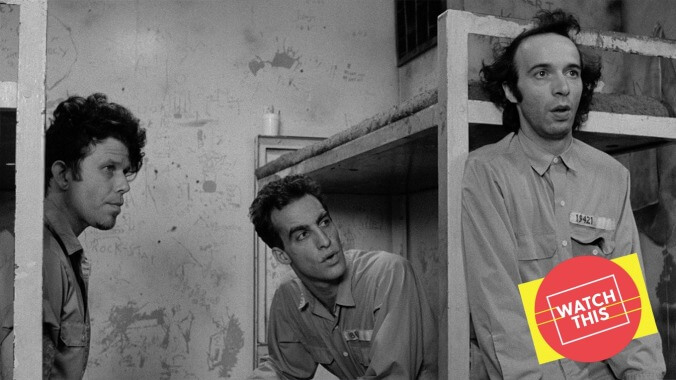Tom Waits and John Lurie helped Jim Jarmusch perfect his indie cool

Watch This offers movie recommendations inspired by new releases, premieres, current events, or occasionally just our own inscrutable whims. This week: The Janelle Monáe thriller Antebellum was supposed to hit theaters. In its absence, we’re looking back at films starring musicians.
Down By Law (1986)
No director played a bigger role than Jim Jarmusch in turning the American indie—a category that was then still associated with B genre movies and realist dramas—into an object of hip cool. And among his name-making 1980s films, none feels cooler than his third feature, Down By Law. From its opening tracking shots of New Orleans set to Tom Waits’ “Jockey Full Of Bourbon” to the sharply detailed black-and-white cinematography, Jarmusch’s take on mismatched-buddy comedies and classic blues motifs represents his early peak as an artistic tastemaker. There’s the cast, too, led by two musicians and an Italian star: Waits, John Lurie (who also wrote the score), and, in his American debut, Roberto Benigni.
It would be an understatement to say that Jarmusch, who also makes music, likes casting musicians. His movies are filled with buddies, heroes, and fellow travelers. Over the years, that’s included Joe Strummer, Screamin’ Jay Hawkins, and three members of the Wu-Tang Clan. Waits has acted in three of his films and so has Iggy Pop (whose total rises to four, if you count the documentary Gimme Danger). And the roles Waits and Lurie play in Down By Law are nothing if not tailored to their respective personae. The former rolls around in his unmistakable baritone as Zack, a hepcat loser and former radio DJ; the latter, who also co-starred in Jarmusch’s classic Stranger Than Paradise, applies his understated deadpan as Jack, a hapless small-time pimp.
Benigni’s role as the Italian tourist was similarly custom-made. Much of his alternately profound and malapropistic dialogue (including the defining line of Jarmusch’s filmography, “It is a sad and beautiful world”) was either improvised or inspired by things the actor had said on and off set in his limited English. For most American viewers, Benigni is largely associated with the maudlin Life Is Beautiful, but his role in Down By Law is one of the most perfect comic performances of the ’80s. Of course, he was at the time completely in the States. Jarmusch had befriended him at a film festival where they were both serving on the jury.
It’s worth remembering that, in addition to being important mile markers of the early Sundance era, Jarmusch’s ’80s films were among the first American indies to come out of an international film scene and a culture of film festivals. The German director Wim Wenders had provided Jarmusch with film stock to shoot the short that became Stranger Than Paradise, and Wenders’ longtime director of photography, the late, great Robby Müller, ended up shooting Down By Law. (Müller was not the only notable non-American in the crew; the singular Claire Denis was Jarmusch’s assistant director.) In fact, Down By Law often feels more like a European film than an American one. It has an outsider’s eye for dilapidated Americana, courtesy of Müller, and a level of artificial minimalism that was then associated with the foreign arthouse.
Jarmusch had never actually been to New Orleans when he wrote the script. It was instead his fondness for blues and New Orleans R&B that inspired the story. Which is to say that Down By Law is a music-influenced movie that stars a couple of musicians who were putting their own spins on genres with Louisiana roots. Lurie, who would eventually retire from both music and acting due to chronic health problems, purveyed post-no wave “fake jazz” via his tongue-in-cheek combo The Lounge Lizards. Waits was already a master of a personal collage of old, weird American sounds; his sublime New Orleans booze montage “Tango Till They’re Sore” plays over the end credits.
Like a number of Jarmusch’s films, Down By Law is broken up into distinct parts. The first follows Jack and Zack separately on one ill-starred night, occasionally crossing paths with Bob; the second finds the three men in jail; the third follows them after their jailbreak. In typical Jarmusch fashion, we never really learn how they escape. There’s an element of ironic detachment to Down By Law—a certain self-awareness about that American mythology that comes from the blues. Jack and Zack are hard-luck cases with woman troubles who end up behind bars for crimes they didn’t commit. They run away with Bob (who is actually guilty) into the bayou and end up parting ways at a crossroads. That’s about as archetypal as it gets.
But there’s also an unmistakable sincerity to the film, often voiced by Bob, the best of the many foreign tourists found in Jarmusch’s films. (Nicoletta Braschi, who would later marry Benigni and become his frequent co-star, adds a touch of folk fantasy to the scenario as a cook who lives in the woods.) One could argue Jarmusch has gone on to direct a number of films better than Down By Law, or at least ones with a lot more dramatic ambition and depth. But his third feature is still the most enchanting iteration of his career-long ambition to make bittersweet fairytales out of overlooked and strange America.
Availability: Down By Law is currently available for digital rental and purchase on Amazon Prime and iTunes.